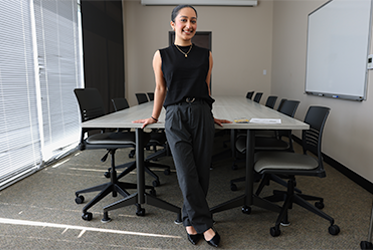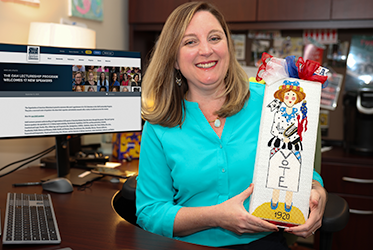

KENNESAW, Ga. | Nov 12, 2025

DEF CON, which began in 1993, is an international cybersecurity conference. It’s also one of the biggest conferences for hackers in the world. One of the main goals of the conference’s various subsets, or policy villages, is to introduce different perspectives on technology and policy making to different audiences, including government officials, computer engineers, and technical hackers.
Volker Franke, professor of conflict management, and Amer Alnajar, an International Conflict Management Ph.D. student working with Franke as a graduate research assistant, decided to add the perspective of social scientists to the DEF CON mix by running a crisis simulation with a humanitarian angle.
“We had simulated a cyberattack on a nuclear reactor in Switzerland. In the simulated event, we had some radiation fallout, and people needed to be evacuated,” Franke said. “This is where we get to the humanitarian response. What needs to be done to get people away from the reactor?”
Franke, who has 25 years of simulation design experience, said approximately 70 people participated in a tabletop version of the simulation. Some players assumed roles that resembled The American Red Cross and the Federal Emergency Management Agency (FEMA), while others negotiated national responses to the crisis and determined how to prevent future cyberattacks. Franke said being a prominent player at DEF CON extends Kennesaw State University’s national reach by showing its impactful research to new audiences.
“For social scientists to attend a nonacademic conference that is very popular among cybersecurity, computer science, AI, and hacker audiences... this is the place to be. At one point, we were told there may be members of Congress who attend our simulation,” Franke said.
Franke is conducting a case studies program at West Point on cybersecurity with the Army Cyber Institute and hopes to publish their simulation as part of that program. He and Alnajar are adapting the simulation scenario by moving the event from Switzerland to Poland’s MARIA nuclear reactor, with a working title of “Attacking MARIA.” They’re also examining how future simulated scenarios can be more effectively adapted with the assistance of AI.
Alnajar’s research extends into AI Large Language Models (LLM), which are “advanced AI systems that can understand and generate natural language.” He is interested in their potential in more effectively designing and running simulations.
“I’m still in the initial stages of researching how AI can be implemented, and of course, this requires guidance from Professor Franke because AI in this context is a tool, not to replace humans with our designers or facilitators,” Alnajar said. “It should be used as a tool, and in [a] very careful and cautious way. We should be aware of all of its aspects, specifically the ethical ones.”
An ambitious goal of their research is to utilize AI when a simulation lacks enough human players to operate effectively. Their hope is to use AI to mimic the roles of humans in the simulation alongside actual human participants. Franke said they are “two or three steps away” from being able to fully dig into that aspect of their research.
Alnajar said AI could also accelerate the design timeframe for simulations. For example, Franke said Alnajar programmed AI to quickly find out what the effects and impact of their simulated cyberattack in Poland would be 72 hours after the strike; a process which “is so intricate that it would require a week of research to figure out what that might be.” Alnajar said AI is valuable in forecasting the quantitative implications of simulated crises by providing numbers about casualties, refugees, and dislocated citizens in significantly less time.
“[We’ve] used it so far in... having control in the simulation parameters and variables. [We’ve] used it so far in forecasting to inform all the designers or facilitators... how to control the level of realism of a simulation, and it’s all contingent on the goals of the simulation and the audience,” Alnajar said.
According to Franke, one of the goals of every simulation that he runs is to connect the player with what’s happening in the simulation on a personal level. He wants to create an impactful teaching landscape for students like Alnajar by involving them in both actual research and connecting them emotionally with the topic or scenario at hand. They also received positive feedback from players at DEF CON 33.
“I believe what we brought [to the conference] is a great experience to show different perspectives, policy makers sitting in the chair of hackers and hackers looking at it from a policy maker perspective,” Alnajar said. “I believe there is a great potential and future for participating next year.”
- Story by Noelle Lashley

CNN Journalist Advances His Career with Radow College Master's Degree

MPA Students Excel at Books and Bowl Games

KSU Public Relations Student Represents University in International Subcommittee

Radow College Assistant Professor of History Chosen for Organization of American Historians Distinguished Lectureship Program